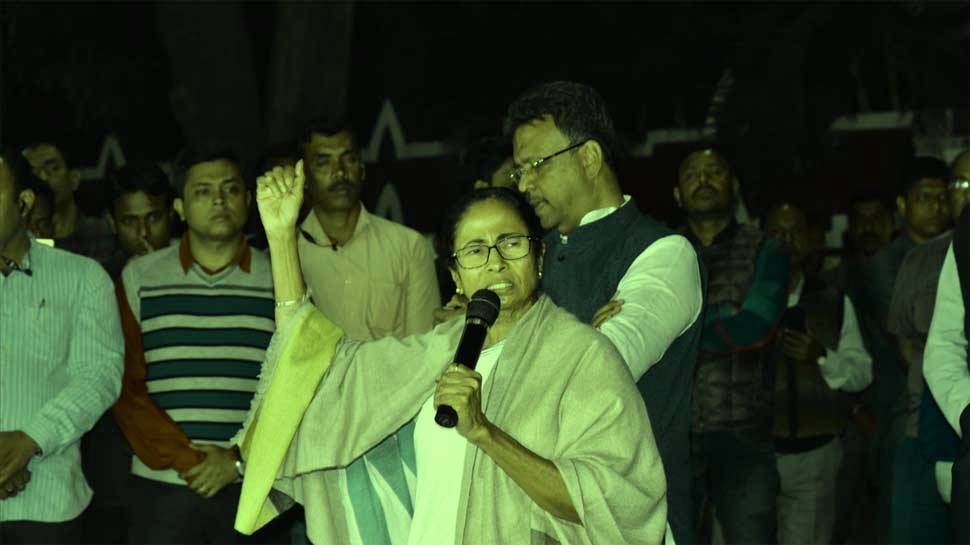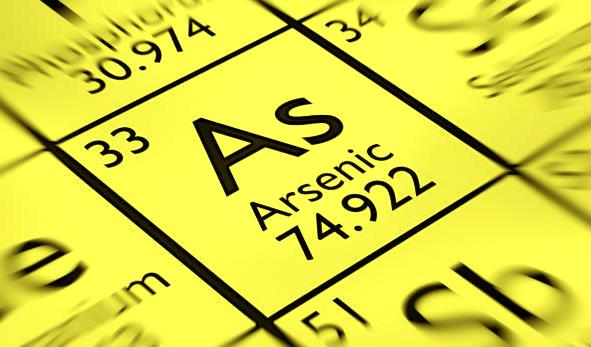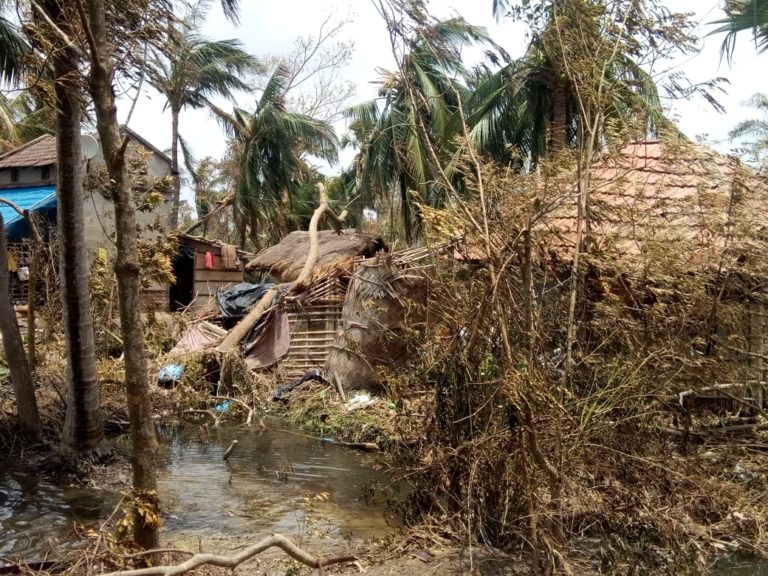
Md. Ziaul Ahmed has fearful memories of howling winds blowing away tin-covers of houses when cyclone Amphan hit the eastern coast of India on May 20. The 35-year-old who lives on Kultali island of Sundarbans, the world’s largest mangrove ecosystem, considers himself lucky to have survived after having being shifted to a relief camp by a rescue team, hours before the disaster struck.
The images of the devastation continue to give him sleepless nights. “I have never heard or seen something like this ever before. The coronavirus outbreak has been followed by cyclone Amphan. It seems to be doomsday because Allah (almighty) is furious at human beings and has been punishing us by letting lose one fury after another,” he said, as his five-year-old daughter sat beside him, listening in.
Cyclone Amphan made its landfall in West Bengal between Digha and Hatiya on the afternoon of May 20, as a very severe cyclonic storm with sustained wind speeds of 155-165 kilometres per hour spiralling up to 185 kilometres per hour. The coastal state of Odisha and the neighbouring country of Bangladesh were also impacted by the cyclone.
Measures to check the spread of COVID-19 pandemic have compounded efforts to keep people safe from cyclone Amphan even as migrant workers return home.
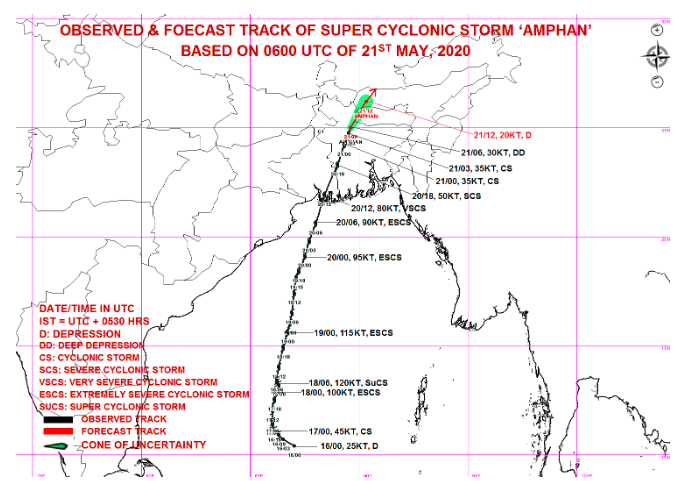
Sundarbans worst hit by the cyclone
Shyamali Pramanik, a 30-year-old homemaker who lives at Ghormara island in Sundarbans, broke down as she returned to the island, two days of Amphan along with her husband and minor daughter, “I had left livestock and a mud house before being shifted to a relief camp but nothing is left now except a collapsed wall with no roof. I sold eggs and livestock for livelihood but everything is gone. Soon, the rising water and erosion will wipe off our existence,” said Pramanik.
Ghoramara island, that had a population of over 5,000 as per the 2011 census of India, now has just 650 people living on it. Most of them have fled over the years because of rapid erosion and rising water level shrinking it every day.
River embankments have been breached in South and North 24 Parganas districts in West Bengal, leaving several houses inundated as water through the breaches slipped into remote settlements, mostly in the Sundarbans.
While most districts of West Bengal are impacted, the Sundarbans region is the worst hit because it is an ecologically fragile zone. The region is yet to recover from the damage caused by Cyclones Aila, Fani and Bulbul in the past.
Among the worst affected districts in West Bengal are Howrah, Hooghly, North and South 24 Parganas, Kolkata, East and West Midnapore, Nadia and East Burdwan.
The state government has confirmed that 86 people have lost their lives in West Bengal while the financial losses for the state have been pegged to around 1 lakh crore ($15.38 billion). Most of the casualties were due to electrocution, falling trees and collapsing structures.
Two days after the tragedy, Indian Prime Minister Narendra Modi along with West Bengal Chief Minister Mamata Banerjee took a joint aerial survey of the affected areas on May 22 and declared an advance assistance fund of Rs 10 billion for the relief work.

Read more: [Analysis] Cyclone Amphan puts focus back on millions displaced by climate disasters
Millions of people left homeless
The West Bengal government estimates that 21,560 sq km of area has been affected in the cyclone impacting the lives of millions of people.
According to media reports, the chief minister has said that three lakh (300,000) people have been evacuated to relief shelters in West Bengal.
According to Mrityunjan Haldar, disaster management official, East Midnapore, the capacity of permanent cyclone shelters to house people has reduced to one-tenth in compliance with social distancing norms. The district has 43 multipurpose cyclone shelters spread across seven blocks.
“We could house 20 to 30 people in one room but now we have instructed that not more than five people should be housed in one room. We have 43 multipurpose cyclone shelters in the district and 17 departmental shelters and we have identified 550 temporary shelters such as school building etc.,”
“Earlier each shelter could house 2000 people. Now the target is 200 per shelter. These shelters, however, are not housing migrant returnees in quarantine.”
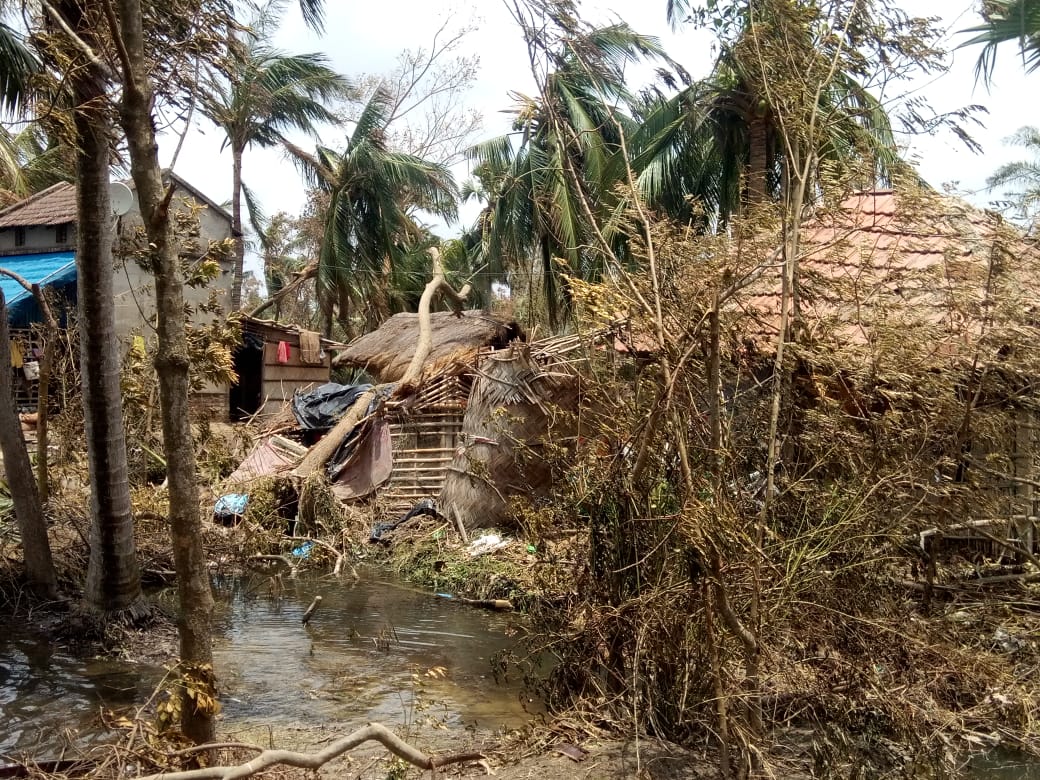
Farmers severely hit by cyclone
Apart from human and livestock casualties, the cyclone has caused severe losses to farmers by destroying their standing crops of paddy, mangoes, lychee when it was a time for harvest.
Burdwan (East) which is the largest paddy growing district of the state has suffered an estimated of around Rs. 3 billion.
According to media reports, the state agriculture minister Ashish Banerjee had indicated that Cyclone Amphan has impacted the farming sector in at least 14 of the 23 districts in West Bengal and the loss incurred may create an all-time record.
For mango growers in Murshidabad and Malda districts of West Bengal are no different as the unfavourable climatic conditions coupled with lockdown had already led to severe losses, “The mango production sustained severe damage due to unseasonal rains and hailstorms during February-March, this year when the flowers were sprouting. As a result, 70 percent of the crop got destroyed. The cyclone has finished whatever little was left. The financial crisis would have a long-term impact as it might deter farmers from mango cultivation next year. We fear that around 38,000 tonnes of mangoes have been destroyed in the cyclone,” Sayed Nurul Islam, 50, a mango farmer at Poranpur village in Malda district, told Mongabay-India. Malda produces around 500,000 tonnes of mangoes every year with around 4 lakh people dependent on the mango trade.
Several parts of Kolkata without power, internet and water
Soon after the fury of the storm subsided, the snapped electrical wires and damage to water pipes led to power outages and water shortages in pockets across the state and in the state capital of Kolkata.
“We have been living without power and potable water for over 60 hours. The power utility company has said that it would take at least another few days to restore the power supply as the wires have got snapped in various places,” said Sujay Verma, 38, a software engineer who lives in EM bypass area of Kolkata.
“The lockdown had already made it difficult to arrange water cans from the market. The cyclone has only added to our woes. We are ready to shell double the amount for water cans but still, nobody is willing to come to our apartment fearing the risk of virus getting spread. The administration should have made arrangements for speedy repairs as the severity of the cyclone was known beforehand,” said Anjana Biswas, 42, a homemaker in central Kolkata.
The absence of internet further compounded the woes as the official work came to a complete halt.
Protests broke out in several pockets of Kolkata for the delay in restoring normalcy.
The city airport was flooded in rainwater causing damage to a small private aircraft which was parked in a hangar and two hangars were destroyed.
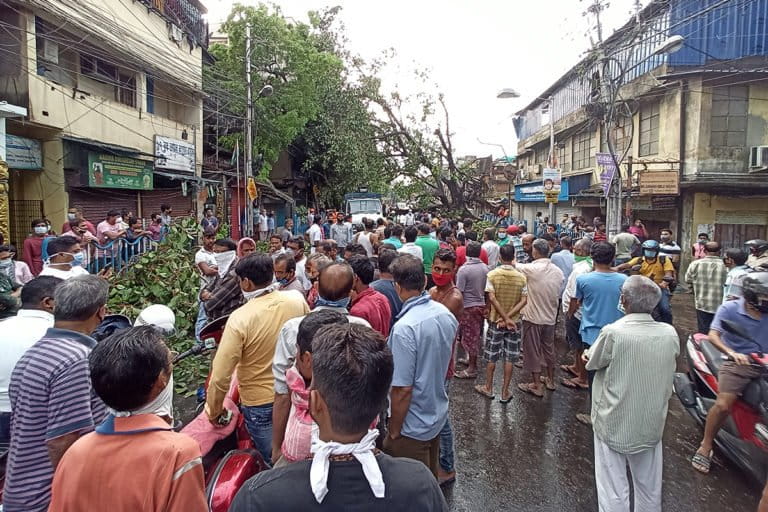
Radio saves lives
At a time when internet and power connectivity had died down, radio proved to be of great help for the administration and those trapped in the affected areas across the state.
The Very High Frequency (VHF) HAM radio stations were used to rescue people caught in the midst of the severe cyclone, “We operated 37 VHF HAM radio stations with the help of our 42 volunteers spread in various districts of the state. Our volunteers communicated the information about people trapped in affected areas to the administration who in turn sent National Disaster Response Force (NDRF) teams for their rescue. We have managed to save around 8000 people and sent them to safer locations,” said Ambarish Nag Biswas, founder of West Bengal Radio Club comprising radio enthusiasts as its members. “We also managed to arrange ambulances for the people after getting messages on radio. We have saved the lives of several people because of radio.”

Thousands of trees uprooted destroying environment and livelihood
The heavy rainfall brought by the cyclone uprooted over 5,000 trees as well as several lampposts and traffic signals across the state. “We had around 150 trees but all have got uprooted in the fierce storm. Most of the trees were over eight decades old but everything has got destroyed. We depended on selling timber for livelihood but nothing is left anymore. The lockdown had already caused substantial damage to our business and the cyclone has been like a swansong. We have also lost one acre of banana plantation and three acres of sesame plantation,” rued Pranballav Howlader, 62, a farmer-entrepreneur and resident of Bishwanathpur village in North 24 Parganas.
Increase in pollution is a concern post the lockdown. “We are going to witness at least 400 percent rise in the pollution level against the permissible limit of World Health Organisation (WHO) as most of the green cover of the city and districts have been lost in the cyclone. It would take at least seven years for the trees to start absorbing carbon dioxide. The rising air pollution would increase pulmonary diseases,” pointed out Somendra Mohan Ghosh, auto emissions consultant and environmentalist.
With inputs from Sahana Ghosh.
Gurvinder Singh Freelance journalist based in Calcutta, India.
This article is republished from The Mongabay under a Creative Commons license. Read the original article.


